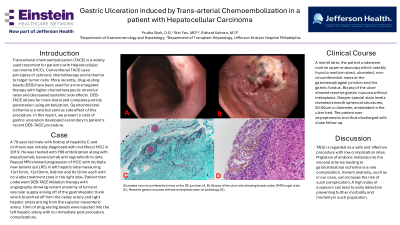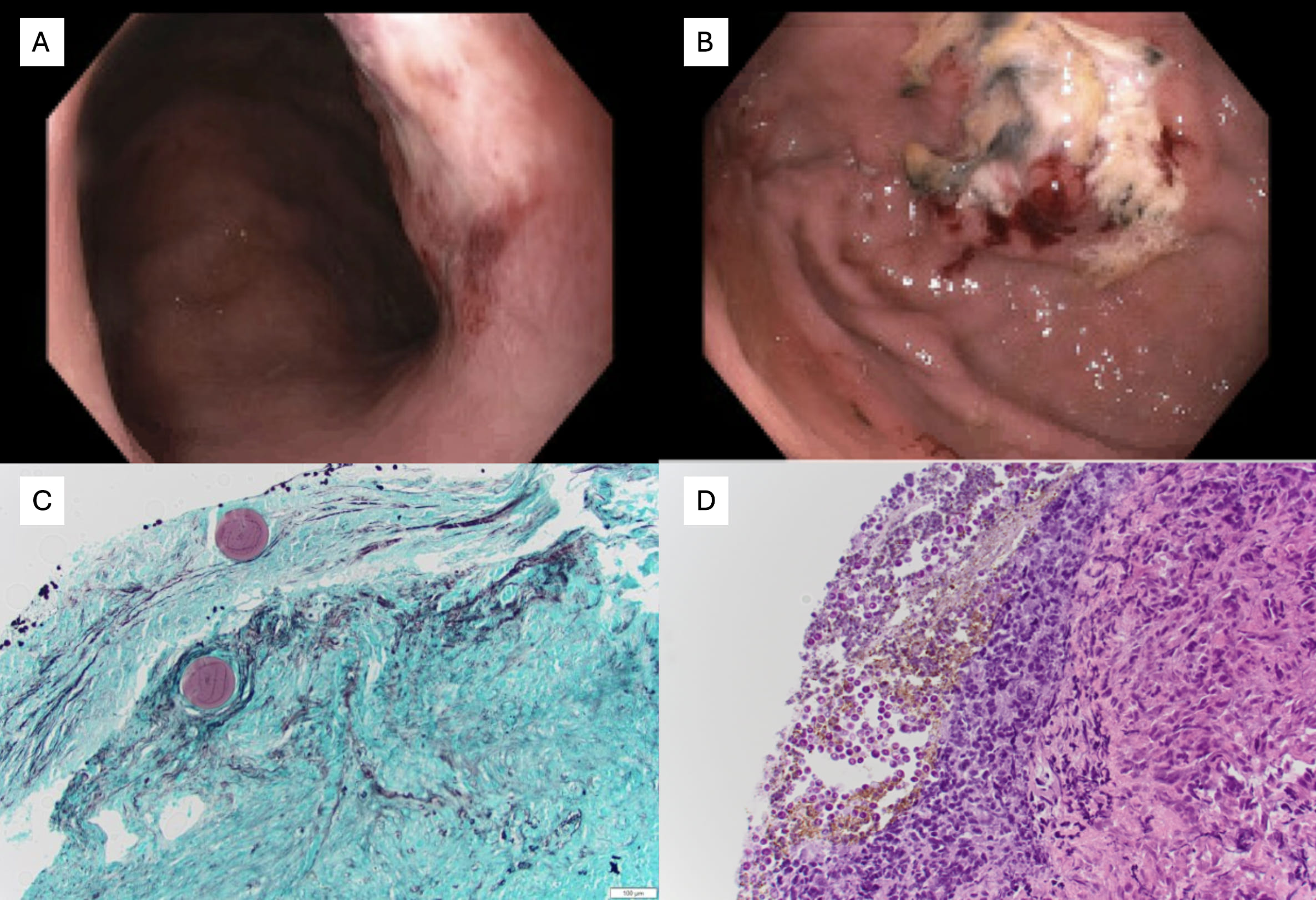Tuesday Poster Session
Category: Stomach
P5076 - Gastric Ulceration Induced by Transarterial Chemoembolization in a Patient with Hepatocellular Carcinoma
Tuesday, October 29, 2024
10:30 AM - 4:00 PM ET
Location: Exhibit Hall E

Has Audio
- PS
Prutha Shah, DO
Einstein Healthcare Network
Philadelphia, PA
Presenting Author(s)
Prutha Shah, DO1, Wei Yan, MD2, Richard Kalman, MD1
1Einstein Healthcare Network, Philadelphia, PA; 2Albert Einstein Medical Center, Philadelphia, PA
Introduction: Transarterial chemoembolization (TACE) is a widely used treatment for patients with Hepatocellular carcinoma (HCC). Conventional TACE uses principles of cytotoxic chemotherapy and ischemia to target tumor cells. More recently, drug-eluting beads (DEB) have been used for a more targeted therapy with higher chemotherapeutic retention rates and decreased systemic side effects. DEB-TACE allows for more distal and complete particle penetration using embolization. Gastrointestinal ischemia is a rare but serious side effect of this procedure. In this report, we present a case of gastric ulceration developed secondary to the patient’s recent DEB-TACE procedure.
Case Description/Methods: A 79-year old male with a history of hepatitis C and cirrhosis was initially diagnosed with multifocal HCC in 2019. He was treated with Yttrium-90 embolization along with atezolizumab, bevacizumab and regorafenib to date. Most recently, a repeat MRI showed progression of HCC with multiple new lesions (all LR5) in the left hepatic lobe measuring 13x15mm, 12x10mm, 8x8mm, and 8x12mm each with no viable treatment zone in the right lobe. The patient then underwent DEB-TACE/Ablation therapy with angiography showing variant anatomy of tumoral vascular supply arising off of the gastrohepatic trunk which branched off from the celiac artery and right hepatic artery arising from the superior mesenteric artery. 10 ml of drug-eluting beads were injected into the left hepatic artery with no immediate post-procedure complications. A month later, the patient underwent routine upper endoscopy which notably found a medium-sized, ulcerated, non-circumferential mass at the gastroesophageal junction and the gastric fundus. Biopsy of the ulcer showed reactive gastric mucosa without metaplasia. GMS special stain revealed smooth spherical structures, 50-60um in diameter, embedded in the ulcer bed with superficial fungal growth surrounding it. The patient was asymptomatic and thus discharged with close follow-up.
Discussion: TACE is regarded as a safe and effective procedure with low complication rates. Migration of embolic material into the visceral arteries leading to gastrointestinal ischemia is a rare complication. Variant anatomy, such as in our case, can increase the risk of such a complication. A high index of suspicion can lead to early detection preventing further morbidity and mortality in such populations.

Disclosures:
Prutha Shah, DO1, Wei Yan, MD2, Richard Kalman, MD1. P5076 - Gastric Ulceration Induced by Transarterial Chemoembolization in a Patient with Hepatocellular Carcinoma, ACG 2024 Annual Scientific Meeting Abstracts. Philadelphia, PA: American College of Gastroenterology.
1Einstein Healthcare Network, Philadelphia, PA; 2Albert Einstein Medical Center, Philadelphia, PA
Introduction: Transarterial chemoembolization (TACE) is a widely used treatment for patients with Hepatocellular carcinoma (HCC). Conventional TACE uses principles of cytotoxic chemotherapy and ischemia to target tumor cells. More recently, drug-eluting beads (DEB) have been used for a more targeted therapy with higher chemotherapeutic retention rates and decreased systemic side effects. DEB-TACE allows for more distal and complete particle penetration using embolization. Gastrointestinal ischemia is a rare but serious side effect of this procedure. In this report, we present a case of gastric ulceration developed secondary to the patient’s recent DEB-TACE procedure.
Case Description/Methods: A 79-year old male with a history of hepatitis C and cirrhosis was initially diagnosed with multifocal HCC in 2019. He was treated with Yttrium-90 embolization along with atezolizumab, bevacizumab and regorafenib to date. Most recently, a repeat MRI showed progression of HCC with multiple new lesions (all LR5) in the left hepatic lobe measuring 13x15mm, 12x10mm, 8x8mm, and 8x12mm each with no viable treatment zone in the right lobe. The patient then underwent DEB-TACE/Ablation therapy with angiography showing variant anatomy of tumoral vascular supply arising off of the gastrohepatic trunk which branched off from the celiac artery and right hepatic artery arising from the superior mesenteric artery. 10 ml of drug-eluting beads were injected into the left hepatic artery with no immediate post-procedure complications. A month later, the patient underwent routine upper endoscopy which notably found a medium-sized, ulcerated, non-circumferential mass at the gastroesophageal junction and the gastric fundus. Biopsy of the ulcer showed reactive gastric mucosa without metaplasia. GMS special stain revealed smooth spherical structures, 50-60um in diameter, embedded in the ulcer bed with superficial fungal growth surrounding it. The patient was asymptomatic and thus discharged with close follow-up.
Discussion: TACE is regarded as a safe and effective procedure with low complication rates. Migration of embolic material into the visceral arteries leading to gastrointestinal ischemia is a rare complication. Variant anatomy, such as in our case, can increase the risk of such a complication. A high index of suspicion can lead to early detection preventing further morbidity and mortality in such populations.

Figure: (A) Gastroesophageal junction ulceration. (B) Ulcer in the gastric fundus. (C and D) Biopsy taken from the gastric fundus revealing numerous spherical structures on a special GMS stain with surrounding inflammatory cells.
Disclosures:
Prutha Shah indicated no relevant financial relationships.
Wei Yan indicated no relevant financial relationships.
Richard Kalman indicated no relevant financial relationships.
Prutha Shah, DO1, Wei Yan, MD2, Richard Kalman, MD1. P5076 - Gastric Ulceration Induced by Transarterial Chemoembolization in a Patient with Hepatocellular Carcinoma, ACG 2024 Annual Scientific Meeting Abstracts. Philadelphia, PA: American College of Gastroenterology.
